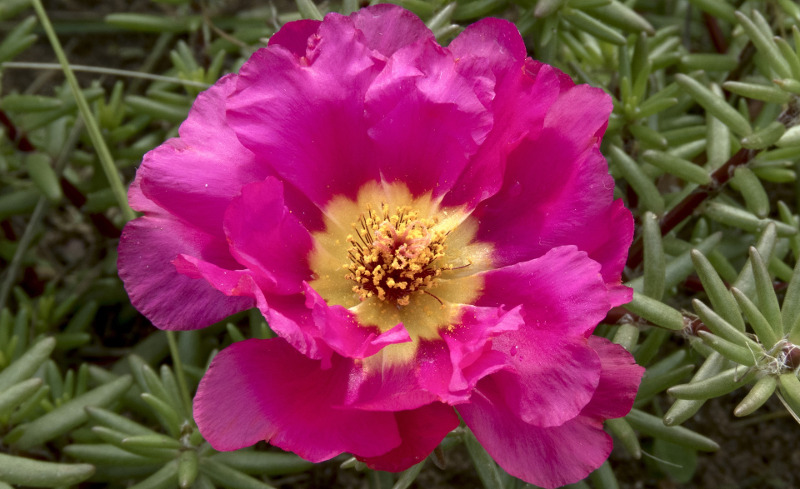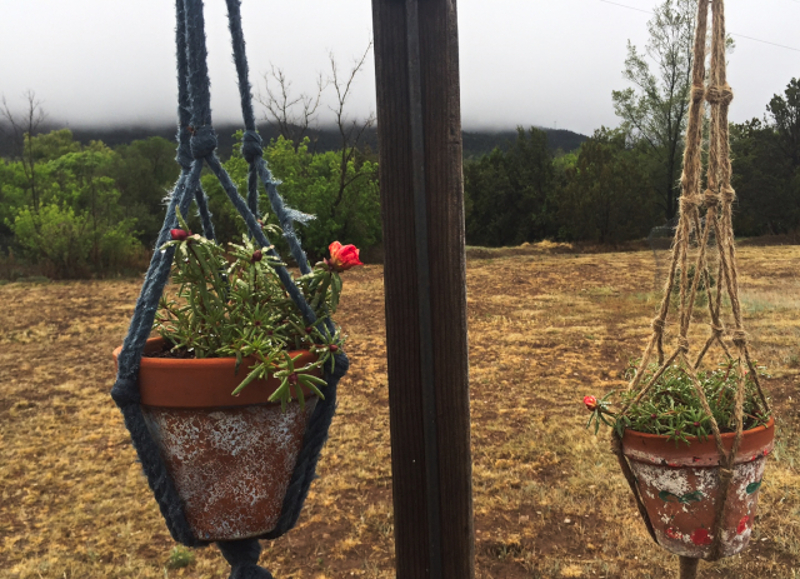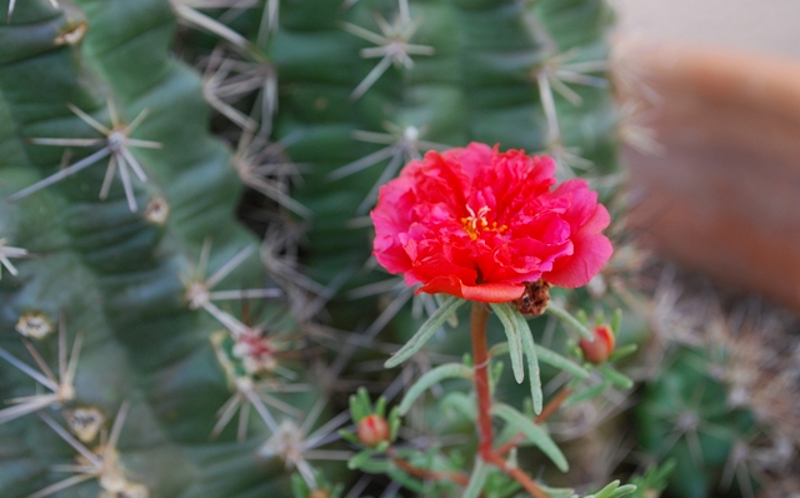Purslane (Portulaca umbraticola) is an annual succulent in the family Portulacaceae. Approximately forty cultivars are currently grown. Its specific epithet oleracea means "vegetable/herbal" in Latin and is a form of holeraceus. Also called little hogweed, pigweed, fatweed, and pusley, Purslane is popular for its nutritional and medicinal uses. Grown as a short-lived perennial in zones 10-11, this drought-tolerant succulent has small flowers that bloom in yellow, orange, white, or pink. Growing 4-8 inches tall with a width of 12-16 inches, this beautiful trailing succulent is perfect for spillers in containers, hanging baskets or as ground cover. Blooms best when planted in full sun.

Portulaca is an annual, but can re-seed. Although not nearly as invasive as its purslane relative, an ornamental portulaca often pops up somewhere in the landscape.
Planting Purslane
Purslane plants are extremely easy to grow. In fact, you may have already seen them popping up in your flower or vegetable gardens. This drought tolerant succulent is not picky about soil as long as it is well drained. Plant it in an area that will get full sun and lots of heat such as near a sidewalk, brick wall or in a container. Space the plants 8-10 inches apart and mulch around the base to control spreading. Water occasionally during dry conditions.
Watering Purslane
Purslane is a succulent plant, meaning that it thrives in soil that is dry but not parched. It is best to not overdo it with watering. This heat loving plant can easily die if watered too much. It is best to give this plant a drink when the top of the soil is dry to the touch one inch down. As long as the soil is well-draining, an average amount of moisture each time will do. Water at the base of the plant to avoid fungal issues.
The easy-care, drought tolerant annual is perfect for gardens any time temperatures begin to warm up in early summer. The worst thing you can do is overwater the plant, especially if it’s in potting mix. The portulaca will grow leggy or even die if its overwatered.

Portulaca actually do better with sun and heat, but who would have thought it would be 40 degrees F in mid-May? I can’t wait for these containers at the back of our garden to fill in.
Fertilizing Purslane
Purslane is one of the easiest plants to care for. Often considered invasive, this plant will grow in some of the worst conditions. Purslane does not need fertilizer to survive. When newly planted, you can add some compost to the soil or a slow release fertilizer. This can enhance growth and encourage better flower production. A standard 20-20-20 fertilizer will do just fine.
Pruning Purslane
Purslane is a fast growing flowering plant. To prevent it from taking over your garden area, trim the plant back 2 inches when needed. Oftentimes, gardeners will harvest the entire succulent even before it flowers. Portulaca will keep blooming and spreading into fall, provided you do one thing: pinch off spent blooms. The energy will go to helping new blooms form. The equivalent of deadheading this annual is so simple; just pinch the blooms off into your hand after they have closed up and begun to look withered. If the flower resists, wait a day. You’ll soon recognize the difference between a bud and a spent bloom.

You can see the bloom stages really well in this photo. A tiny dried-up flower peeks from behind the bloom; it’s ready to pinch off! Two new buds are a little lower on either side of the stem. And a faded bloom, nearly ready to pinch, lies at the lower right.
Caring For Purslane in Pots
Purslane is the perfect spiller plant for hanging baskets and containers. Choose a container that has good drainage holes as this plant loves hot dry conditions. You can grow six 4 inch plants in a 12 inch pot. Plant in commercial potting soil and fertilize once at planting time. No additional feeding is necessary. Water when the soil feels dry. Do not over water as this plant likes dry conditions.
Winter Care for Purslane
Purslane is an annual plant that will die with the first hard frost. This heat loving plant loves hot dry conditions and will not survive cold temperatures. Container grown Purslane can be brought indoors during the cold weather months. Place the plant in a warm area that will get direct sunlight each day. Purslane is a succulent plant that requires minimal watering . Trim the plant stems by 2 inches if it becomes overgrown.
Common Purslane Care Questions
What Is Purslane Good For?
Purslane is often referred to as portulaca and is a low growing, flowering ground cover or spiller in containers. It is also said to be loaded with antioxidants, vitamins, and minerals and have many health benefits.
Is Purslane Invasive?
In many parts of the world, purslane is touted as a delicious treat, with some medicinal qualities but in others, it is considered a nuisance, and difficult to get rid of the nuisance. If you don't want it in your yard, don't let it go to seed, they've been known to be viable after 40 years, resting in the soil!
Does Purslane Grow In Shade?
To really thrive and do it's best, purslane needs full sun. They also love the heat. However, if you're trying to encourage flowering, some shade or protection from the sun during the hottest part of the day will help.
Is Purslane Succulent?
Indeed, purslane is a member of the succulent family.
How To Eat Purslane?
All parts of the purslane plant are edible, from the stems to the flower buds. It can be eaten raw, cooked, or the leaves can be steeped as tea. They're touted as good in salad, stir fry, or on a sandwich. The flavor is a bit salty and similar to spinach or watercress.
Do Purslane Flowers Open And Close?
The flower of the purslane close up at night but open right back up along with the sunrise each morning, attracting butterflies all day long.
Is Purslane Annual Or Perennial?
Purslane is an annual in all but the warmest climates in the country, but it does self-seed.
Do Portulaca Spread?
Portulaca will self-seed, so if you want it to spread, leave some flowers on at the end of the season, and let the seeds ripen.
Why Do Portulaca Leaves Turn Yellow?
Most often, yellowing leaves on succulents, including portulaca, is caused by over-watering which causes damage to the roots. Damaged roots are unable to absorb moisture, or nutrients from the soil, which ultimately turns the leaves yellow.
Have a question about Purslane? Fill out the form below and we will try and get back to your question as soon as possible. We may even feature your question on this article to help other gardeners!
 |
Author Chris Link - Published 09-08-2021 |
